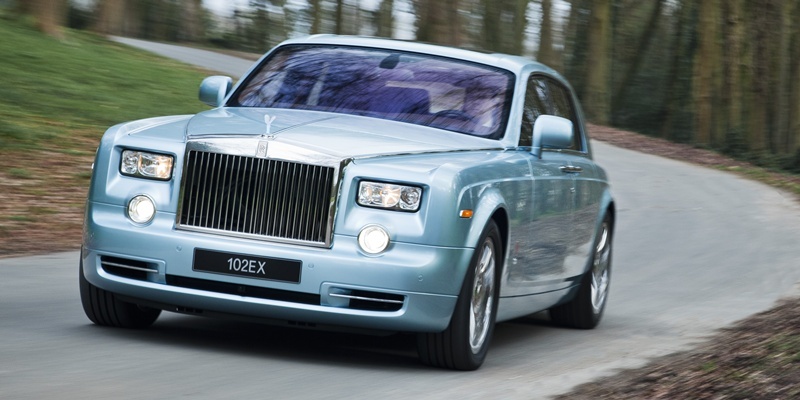Dundee battery manufacturer Axeon has made the power system for the world’s first electric Rolls-Royce. As the prototype car embarks on a tour of well-heeled customers around the world, The Courier’s Jack McKeown was one of the first journalists to drive the only electric Roller in existence.
Sales director George Paterson predicts, “Electric vehicles will be able to do things conventional cars can’t. You’ll be able to programme them to switch on and turn on the heater so the car’s warm when you get in it. This will be done while it’s still plugged in, so it won’t dent battery capacity.”
Murray Motors sales manager Brian Dickson lets me drive a petrol powered version before driving the EE.
The 1955 Silver Cloud was advertised with the line: “At 60mph the loudest noise in this new Rolls-Royce comes from the electric clock.” In 2011, much the same is true the only sound inside is the gentle whoosh of the fans keeping the car cool on this warm day and the click of the indicators at junctions. When both are off the car is utterly silent.
I’ve driven Bentleys, high-end BMWs, Audis and Mercedes, and I’ve never been in a car that’s even close to being as quiet and cosseting as this. But then it does cost £315,000.
The Edinburgh dealership sells around a dozen of the cars a year. Brian says most of them go to self-made men very few company chief executives or chairman get them these days.
When I get back the EE is charged up and I take it for a drive around the streets of Edinburgh. In other electric cars, such as the Nissan Leaf, the first thing you notice is the lack of engine noise. Because the V12 Phantom’s engine is virtually silent and the car already makes you feel deaf to the outside world, the most obvious benefit of the electric vehicle driving experience is negated.
In fact, the EE is pretty much indistinguishable from the V12 Phantom. Because electric cars have no gears they deliver all of their torque, or pulling power, instantly, so the EE wafts away on an effortless wave of power.
I drove gingerly the car is the only one in existence and represents several million pounds worth of development costs and I have no wish to become known as the journalist who wrecked it but on an open stretch of road I floor the accelerator and we surge forward.
Ever with an eye on keeping ahead of their arch rival Bentley, Rolls-Royce have used the EE to test other technology developments. Its weirdly translucent paint is the result of nano-sized chrome particles being set in no fewer than 18 separate layers of paint, while the seats’ leather hide has been exposed to a vegetable tanning process that gives more natural lines and creases.
Next month, the car will head to Singapore and then Beijing, before going to Los Angeles and then on a tour of Europe before its year-long world tour continues in New York, Las Vegas and Miami. By the time it returns, 500 Rolls-Royce customers (and their chauffeurs) will have driven and given their opinion on the car.
The Phantom EE is very much a case of Rolls-Royce dipping a toe in the water of alternative power sources unless there’s a clamour from well-heeled customers, there are no plans to put it into production. If they do bring it to market, it will likely be with a price tag exceeding £600,000.
Let’s not kid ourselves, an electric Rolls-Royce is still a 2.7-ton luxury vehicle it’s not a Nissan Leaf, a Toyota Prius, or a bicycle.
But the company is aware that oil is running out and even its ultra-wealthy customers will not want to run 6.75 litre cars for ever. It needs to have a conversation with its customers about how their luxury cars will be powered in the future and the Phantom EE is the first word in that discussion.
Time will tell if the Spirit of Ecstasy is replaced by the Spirit of Electricity.
The Rolls-Royce Phantom EE (Experimental Electric) also known by its project name, the 102EX glides on to the forecourt, imposing and eerily quiet, coming to rest above a pad on the ground.
This induction pad begins silently transferring electricity through the air into the car’s batteries, recharging it for another run.
It’s a little incongruous witnessing the car sashay regally around the Murray Motors Rolls-Royce dealership on a scruffy industrial estate at the edge of Edinburgh their mega-rich customers do not come to Rolls-Royce, Rolls-Royce go to them so it’s better to imagine the electric Phantom making its way up the long drive of a country estate.
The Phantom EE is Rolls-Royce’s first foray into the world of electric vehicles. Its power comes from the expertise of Dundee battery makers Axeon Europe’s leading supplier of lithium-ion batteries, used in electric and hybrid vehicles.
“There were a lot of challenges,” says senior project engineer Steve Douglas. “Most electric vehicles are developed from scratch so you can pack the batteries along the floor, but with the Rolls-Royce we had to fit them into the same space the engine normally occupies.”
In place of the 6.75 litre V12 petrol engine and six-speed gearbox is the largest battery pack ever fitted to a passenger car. Ninety-six lithium-ion cells drive two electric motors delivering 290 kilowatts that’s 389bhp in old money. By contrast Nissan’s electric Leaf has 90KW of power.
“A silent vehicle lets you get closer to the animals and we’re working on a solar charging system,” explains spokeswoman Rebecca Trengove.
Improving the range of electric cars is the next challenge, Rebecca says.
“Battery capacity is not improving as fast as Moore’s Law (which states that computing hardware power will double every two years) but it is getting better.”
Continued…
